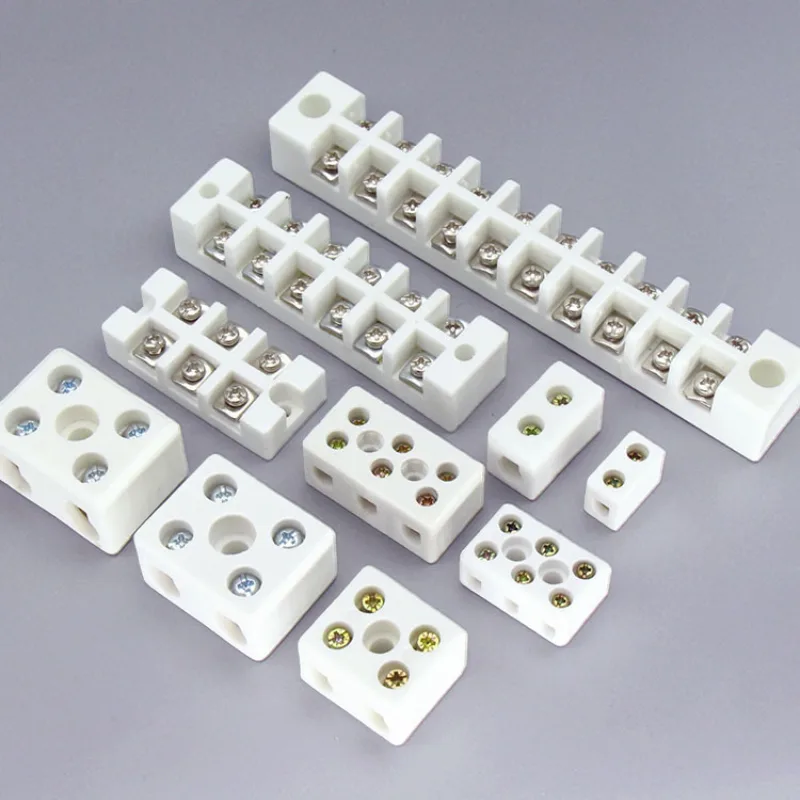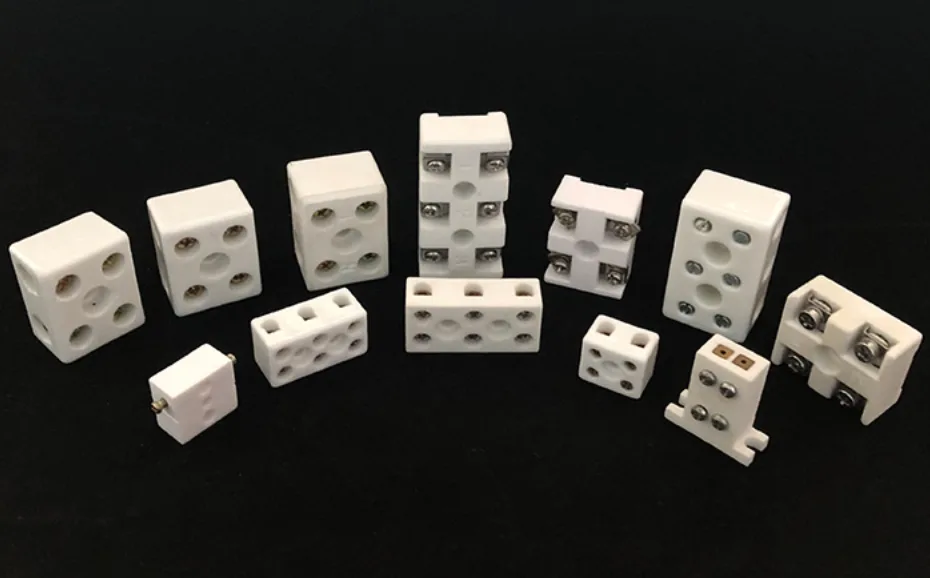Úvod do keramických svorkovnic
Ve světě elektrických spojů je spolehlivost v extrémních podmínkách prvořadá. A právě zde... keramické svorkovnice lesk. Tyto specializované elektrické součástky, vyrobené z vysoce kvalitního porcelánu nebo steatitu, poskytují bezpečné spojení a zároveň odolávají teplotám, které by roztavily standardní plastové alternativy. Ať už pracujete s průmyslovými zařízeními, topnými systémy nebo energetickými rozvodnými sítěmi, znalost keramických svorkovnic je nezbytná pro zajištění bezpečného a odolného elektrického spojení v náročných prostředích.
Co jsou keramické svorkovnice?
Keramické svorkovnice (nazývané také porcelánové svorkovnice) jsou elektrická propojovací zařízení vyrobená z keramických materiálů odolných vůči vysokým teplotám. Obsahují dva nebo více svorek zajištěných šrouby nebo podobnými upevňovacími mechanismy, které jsou navrženy tak, aby bezpečně spojovaly elektrické obvody. Na rozdíl od plastových svorkovnic vynikají keramické verze v extrémních podmínkách, kde je klíčová tepelná odolnost.
Hlavní funkcí keramických svorkovnic je spojování a izolace. Tělo svorkovnice je vyrobeno z odolného keramického materiálu, který elektricky izoluje sousední spoje, zatímco vodivé části jsou obvykle z mosazi nebo jiných korozivzdorných kovů kompatibilních s mědí. Tato kombinace vytváří bezpečný spojovací bod, který udržuje elektrickou izolaci i v náročných podmínkách.
Klíčové vlastnosti a výhody keramických svorkovnic
Vynikající tepelná odolnost
Nejpozoruhodnější vlastností keramických svorkovnic je jejich výjimečná tepelná odolnost. Zatímco standardní plastové svorkovnice začínají degradovat při teplotě okolo 105 °C, keramické svorkovnice odolávají teplotám od 200 °C do 450 °C v závislosti na konkrétním modelu. Některé specializované verze odolávají dokonce teplotám až 650 °C nebo vyšším.
Díky této mimořádné tepelné odolnosti jsou keramické svorkovnice nezbytné pro použití v pecích, vypalovacích lisech a dalších průmyslových prostředích s vysokými teplotami, kde by se plastové součásti rychle roztavily nebo degradovaly.
Vynikající elektrické izolační vlastnosti
Keramické svorkovnice si zachovávají působivé elektrické izolační vlastnosti i při zvýšených teplotách. Typické hodnoty izolačního odporu mohou při teplotách mezi 20 °C a 400 °C přesáhnout 190–300 MΩ, což výrazně překračuje průmyslové standardy. To zajišťuje spolehlivou elektrickou izolaci v aplikacích, kde je kritické zachování integrity obvodu.
Vynikající odolnost a dlouhá životnost
Keramické svorkovnice nabízejí výjimečnou mechanickou pevnost a odolnost, díky čemuž jsou odolné vůči nárazům, vibracím a mechanickému namáhání. Tato robustní konstrukce zajišťuje dlouhodobou spolehlivost v průmyslovém prostředí a snižuje potřebu častých výměn a údržby.
Vysoce kvalitní materiály použité v keramických svorkovnicích jim umožňují zachovat strukturální integritu i za podmínek, které by způsobily rychlé opotřebení plastových alternativ, což se projevuje nižšími nároky na údržbu a zkrácenými prostoji v kritických aplikacích.
Vynikající chemická a korozní odolnost
Další významnou výhodou keramických svorkovnic je jejich výjimečná odolnost vůči chemikáliím, olejům a korozivním látkám, které se často vyskytují v průmyslovém prostředí. Keramický materiál se při vystavení většině chemikálií nedegraduje, což zajišťuje trvalý výkon v náročných prostředích, kde by jiné materiály mohly selhat.
Požární bezpečnost a nehořlavost
Keramické svorkovnice jsou ze své podstaty nehořlavé, což je činí ideálními pro aplikace, kde je důležitá požární bezpečnost. Nepřispívají k nebezpečí požáru a dokáží zachovat integritu obvodu během požáru, čímž zajišťují klíčovou kontinuitu pro poplašné systémy a systémy nouzového vypnutí.
Typy keramických svorkovnic
Keramické svorkovnice se dodávají v různých konfiguracích, aby splňovaly požadavky různých aplikací:
Podle konfigurace terminálu
Uzavřené svorkovnice
Uzavřené keramické svorkovnice mají svorky, které jsou uvnitř keramického pouzdra lépe chráněny. Ty poskytují:
- Zvýšená bezpečnost snížením náhodného kontaktu s živými částmi
- Maximální jmenovité napětí se obvykle pohybuje mezi 380-600 V
- Proudové kapacity od 30 A do 65 A
- Teplotní odolnost do 200 °C
Odkryté svorkovnice
Odkryté keramické svorkovnice mají lépe přístupné svorky a nabízejí:
- Snadnější přístup pro zapojení a údržbu
- Maximální jmenovité napětí 500-600 V
- Proudové kapacity od 15 A do 100 A
- Teplotní odolnost až 240 °C (specializované modely dosahují až 450 °C)
Podle počtu pólů
Keramické svorkovnice jsou k dispozici v různých konfiguracích pólů:
- Jednopólové bloky pro základní zapojení
- Dvoupólové bloky pro duální obvody
- Třípólové bloky pro třífázové systémy
- Čtyřpólové bloky a vyšší pro složitější zapojení
Počet pólů udává, kolik samostatných obvodových spojení lze vytvořit v rámci jednoho bloku, přičemž vícepólové bloky v podstatě kombinují více jednopólových bloků v jednom keramickém pouzdře.
Podle typu montáže
Mezi běžné možnosti montáže patří:
- Bloky montované na panel s otvory pro upevnění k panelům pomocí šroubů
- Bloky montované na povrch určené pro instalaci na rovné povrchy
- Plovoucí bloky, které spojují vodiče bez nutnosti montáže k povrchu
Materiály a konstrukce
Výkon keramických svorkovnic do značné míry závisí na jejich konstrukčních materiálech:
Keramické tělo
Většina keramických svorkovnic používá steatit (typ C221), keramickou směs vyrobenou z přírodního minerálního mastku. Tento materiál nabízí:
- Vynikající dielektrické vlastnosti
- Vynikající teplotní odolnost
- Dobrá mechanická stabilita
- Cenová efektivita ve srovnání s jinými vysokoteplotními izolátory
Keramické tělo je obvykle neglazované s mírně krémovou barvou, ačkoli pro určité aplikace jsou k dispozici i glazované verze.
Komponenty terminálu
Terminály zabudované v keramických blocích jsou obvykle vyrobeny z:
- Mosaz (často jakosti CuZn40Pb2 pro vysokou mechanickou pevnost)
- Poniklovaná nebo pozinkovaná mosaz pro zvýšenou odolnost proti korozi
- Nerezová ocel ve specializovaných aplikacích pro vysoké teploty
Spojovací šrouby jsou obvykle z pozinkované oceli s drážkovanými válcovými hlavami, určené k zajištění vodičů bez jejich poškození.
Běžné aplikace pro keramické svorkovnice
Keramické svorkovnice vynikají v prostředích, kde vysoké teploty, korozivní podmínky nebo obavy ze spolehlivosti znemožňují použití standardních svorkovnic:
Průmyslová zařízení a stroje
Tyto specializované svorkovnice se nacházejí v:
- Zařízení na tavné lepidlo
- Stroje na vstřikování plastů
- Motory pracující ve vysokoteplotním prostředí
- Průmyslová procesní zařízení se zvýšenými okolními teplotami
Topné systémy
Keramické svorkovnice se hojně používají ve vysokoteplotních topných aplikacích:
- Pece a vypalovací pece
- Průmyslové a komerční pece
- Infračervené a křemenné trubicové ohřívače
- Elektrické topné články
- Zařízení pro stravování vyžadující tepelně odolné spoje
Systémy rozvodu energie
V silových aplikacích poskytují keramické svorkovnice:
- Bezpečné připojovací body ve vysokoteplotních oblastech
- Spolehlivý výkon v rozvaděčích
- Odolné spoje v rozvaděčích
- Bezpečné zakončení ve vysokonapěťových systémech
Specializované aplikace
Mezi další důležité způsoby použití patří:
- Zapojení termočlánků při monitorování vysokých teplot
- Požární poplašné systémy vyžadující integritu obvodu během požárů
- Systémy nouzového vypnutí v nebezpečném prostředí
- Aplikace, kde musí spojení zůstat neporušené i za extrémních podmínek
Jak vybrat správnou keramickou svorkovnici
Výběr vhodné keramické svorkovnice vyžaduje pečlivé zvážení několika faktorů:
Teplotní požadavky
Vyberte svorkovnici s teplotní odolností, která překračuje maximální očekávanou okolní teplotu alespoň o 20%, aby byla zajištěna dostatečná bezpečnostní rezerva. Pro aplikace s extrémními teplotními výkyvy zvolte modely speciálně navržené pro zvládání teplotních cyklů.
Elektrické specifikace
Ujistěte se, že jmenovité napětí a proud svorkovnice překračují požadavky vaší aplikace alespoň o 25%, aby se zohlednilo neočekávané zvýšení zatížení nebo napěťové špičky. Při výběru zvažte jak trvalé, tak i špičkové elektrické zatížení.
Kompatibilita velikosti vodičů
Ověřte, zda vybraná keramická svorkovnice správně odpovídá průřezům vodičů použitým ve vaší aplikaci. Různé modely podporují různé velikosti vodičů:
- Menší bloky obvykle zvládnou 26-12 AWG
- Střední bloky obvykle pojmou 20-8 AWG
- Větší bloky mohou akceptovat vodiče od 18 do 4 AWG
Úvahy o životním prostředí
Zhodnoťte jakékoli zvláštní faktory prostředí, které by mohly ovlivnit výkon:
- Vystavení chemikáliím nebo olejům
- Venkovní podmínky nebo podmínky s vysokou vlhkostí
- Nadměrné vibrace nebo mechanické nárazy
- Potenciální vystavení korozivním látkám
Osvědčené postupy při instalaci
Pro optimální výkon a bezpečnost při instalaci keramických svorkovnic:
- Namontujte svorkovnici na bezpečném a stabilním místě mimo dosah nadměrné vlhkosti
- Odstraňte přibližně 1,5 cm izolace z připojovaných vodičů.
- Zasuňte obnažené vodiče zcela do konektorů svorek, dokud se izolace nedotkne svorky.
- Utáhněte šrouby svorek na předepsaný utahovací moment (nepřetahujte je)
- Zajistěte dostatečné mezery kolem svorkovnice pro odvod tepla
- Zvažte ochranné kryty v extrémně náročných podmínkách
Výhody a omezení
Hlavní výhody
Keramické svorkovnice nabízejí řadu výhod:
- Výjimečná tepelná odolnost až do několika stovek stupňů Celsia
- Vynikající elektrická izolace i při vysokých teplotách
- Vynikající mechanická pevnost a trvanlivost
- Vynikající chemická a korozní odolnost
- Nehořlavost a shoda s požární bezpečností
- Prodloužená životnost v extrémních podmínkách
Omezení, která je třeba zvážit
Navzdory svým působivým schopnostem mají keramické svorkovnice určitá omezení:
- Vyšší počáteční náklady ve srovnání s plastovými alternativami
- Větší hmotnost a velikost pro ekvivalentní jmenovité proudy
- Menší rozmanitost možností připojení
- Možnost zlomení při silném nárazu
- Omezená dostupnost specializovaných konfigurací
Navzdory těmto úvahám zůstávají keramické svorkovnice ideální volbou pro aplikace, kde extrémní teploty, náročné prostředí nebo výjimečné požadavky na spolehlivost znemožňují použití standardních svorkovnic.
Srovnávací analýza: Keramika vs. alternativní materiály
Výběr správného materiálu svorkovnice vyžaduje pochopení kompromisů mezi keramikou a jinými běžnými možnostmi. Toto srovnání vám pomůže určit, který materiál nejlépe vyhovuje vašim specifickým požadavkům na aplikaci.
Keramické vs. plastové svorkovnice
Plastové svorkovnice, obvykle vyrobené z termoplastů, jako je polyamid (PA), polykarbonát (PC) nebo polypropylen (PP), se široce používají pro všeobecné použití. Zde je srovnání s keramickými variantami:
Teplotní odolnost
Nejvýznamnějším rozlišovacím znakem je teplotní odolnost. Keramické svorkovnice vynikají provozním rozsahem od 200 °C do více než 650 °C. Plastové alternativy mají mnohem nižší limity, obvykle v rozmezí od 80 °C (polyethylen) do 130 °C (PA66), nad kterými měknou, taví se nebo degradují.
Elektrická izolace
Oba materiály fungují jako izolanty, ale keramika obecně nabízí vynikající vlastnosti, zejména vyšší dielektrickou pevnost a objemový odpor. Díky tomu je keramika výhodná pro aplikace s vysokým napětím a pro udržení integrity izolace při zvýšených teplotách. Keramika se také může pochlubit vyšší odolností proti povrchovým pohybům (CTI > 600) ve srovnání s mnoha plasty.
Mechanické vlastnosti
Keramické svorkovnice poskytují vysokou tuhost a pevnost v tlaku, ale jsou křehké a náchylné k prasknutí při nárazu. Plastové alternativy jsou obecně pružnější, lehčí a mají lepší odolnost proti nárazu, i když se mohou v průběhu času deformovat, deformovat pod tlakem nebo se tečit.
Trvanlivost a odolnost
Keramika vykazuje vynikající odolnost vůči korozi, chemikáliím a stárnutí. Odolnost plastů se liší podle typu, obecně však nabízí dobrou odolnost vůči vlhkosti a běžným chemikáliím. Dlouhodobá spolehlivost v náročném chemickém nebo UV prostředí je však obvykle horší než u keramiky. Keramika je nehořlavá, zatímco plasty mají různou míru hořlavosti (např. UL94 V-0, V-2, HB), což vyžaduje pečlivý výběr na základě požadavků na požární bezpečnost.
Cena a manipulace
Keramika je obvykle dražší kvůli nákladům na materiál a složitým výrobním procesům. Plasty těží z velkoobjemového, automatizovaného vstřikování, což je pro standardní aplikace výrazně efektivnější z hlediska nákladů. Lehké plasty se navíc často snáze manipulují a instalují, zatímco keramika vyžaduje opatrnější zacházení, aby se zabránilo rozbití.
Primární Aplikace
Keramika je nepostradatelná pro aplikace s vysokými teplotami, vysokým napětím, chemicky agresivními látkami nebo kritickými požadavky na požární bezpečnost, kde plasty selhávají. Plasty dominují v univerzálních elektrických kabelech, komerční elektronice, ovládacích panelech v kontrolovaném prostředí a v nákladově citlivých projektech.
| Funkce | Keramické | Plast (PA, PC, PP) |
|---|---|---|
| Max. provozní teplota (°C) | Vysoká (200 až 800+) | Nízká (obvykle 80 až 130) |
| Kvalita izolace | Vynikající (vysoký V, vysoký T, vysoký CTI) | Dobré (standardní V/T) |
| Mechanické vlastnosti | Vysoká pevnost, tuhý, křehký | Nižší pevnost, pružnost, odolnost proti nárazu |
| Odolnost proti korozi | Vynikající | Dobré (liší se podle typu) |
| Hořlavost | Nehořlavý | Liší se (certifikováno UL94) |
| Náklady | Vyšší | Spodní |
| Hmotnost | Těžší | Zapalovač |
Keramické vs. kovové svorkovnice
Kovové svorkovnice, často s použitím mosazi nebo slitin mědi pro hlavní vodivé těleso/platformu, nabízejí ve srovnání s keramikou jiné výhody:
Teplotní odolnost
Keramika je mnohem lepší, je navržena pro vysoké teploty (až 400 °C+). Kovové bloky jsou obvykle omezeny na aplikace se středními nebo nízkými teplotami (obvykle v rozmezí 100–160 °C), což je dáno vlastnostmi kovu a případnými integrovanými izolačními komponenty.
Elektrické vlastnosti
Keramika poskytuje vynikající inherentní elektrickou izolaci. Kovové bloky, které jsou vodivé, se spoléhají na konstrukci zahrnující samostatné izolační bariéry nebo základny a obecně se nepovažují za optimální tam, kde je kritický vysoký izolační výkon.
Kovové bloky však vynikají ve zvládání vysokých proudů díky vysoké vodivosti kovového tělesa (mosaz, měď), což umožňuje minimální pokles napětí. Proudová kapacita keramických bloků je určena velikostí a materiálem zabudovaných kovových svorek, nikoli samotným izolačním tělesem.
Mechanické vlastnosti
Oba materiály nabízejí dobrou odolnost, ale různými způsoby. Kovy poskytují vynikající robustnost, tažnost a odolnost vůči mechanickému namáhání a vibracím. Keramika je také pevná a tuhá, ale je křehká a méně odolná vůči nárazům.
Koroze a výroba
Keramika má inherentně vysokou odolnost vůči korozi. Odolnost kovových bloků proti korozi silně závisí na konkrétní použité slitině a na tom, zda jsou aplikovány ochranné pokovování nebo úpravy.
Z hlediska výroby se kovy relativně snadno vyrábějí pomocí standardních obráběcích, lisovacích a tvářecích procesů. Výroba keramiky je složitější a zahrnuje fáze lisování/vypalování, což ovlivňuje náklady.
Zaměření aplikace
Keramika se volí pro požadavky na vysoké teploty a vysokou izolaci. Kovové bloky se často preferují pro aplikace s vysokým proudem (kde to teploty dovolují), v náročných fyzikálních prostředích (kvůli robustnosti) a pro obecné přípojky inženýrských sítí, kde vysoká izolace není primárním faktorem.
| Funkce | Keramické | Kov (např. mosazné tělo) |
|---|---|---|
| Max. provozní teplota (°C) | Vysoká (400+) | Nízká/Střední (100–160) |
| Kvalita izolace | Vynikající (vlastní) | Špatné (vyžaduje samostatnou izolaci) |
| Současná kapacita | Určeno terminály | Vysoká (vodivé těleso) |
| Mechanická pevnost | Silný, ale křehký | Robustní, tvárný |
| Odolnost proti korozi | Vynikající | Liší se (záleží na kovu/úpravě) |
| Snadnost výroby | Komplex | Snadnější |
| Náklady | Vyšší | Spodní |
Keramika vs. fenol/bakelit
Fenolické pryskyřice (jako bakelit) představují starší třídu termosetických plastů používaných pro elektrickou izolaci. I když jsou v nových instalacích méně běžné, stojí za to je srovnat s keramickými variantami:
- Keramické svorkovnice nabízejí výrazně vyšší teplotní odolnost ve srovnání s fenolickými pryskyřicemi
- Keramika poskytuje vynikající požární odolnost a bezpečnostní vlastnosti
- Fenolické materiály se obvykle používají v aplikacích, kde je dostatečná mírná tepelná odolnost a důležitým faktorem jsou náklady.
- Keramika zůstává preferovanou volbou pro kritické bezpečnostní aplikace a extrémní prostředí
Správný výběr
Optimální materiál svorkovnice závisí na identifikaci primárních požadavků vaší aplikace, spíše než na nalezení jediného „nejlepšího“ materiálu. Zvažte tyto pokyny:
- Vyberte si keramiku když provozní teploty překračují možnosti plastů a kovů, a to i přes jejich vyšší cenu a křehkost
- Vyberte plast pro aplikace s ohledem na okolní teplotu, cenově dostupné aplikace se standardními požadavky na izolaci
- Zvolte kov pro požadavky na vysoký proud v rámci středních teplotních rozsahů
- Zvažte fenolové možnosti pro aplikace s mírnými teplotami, kde je požadována rovnováha mezi výkonem a cenou
Důkladná analýza specifických požadavků vaší aplikace s prioritou klíčových faktorů ovlivňujících výkon, jako je teplotní odolnost, izolační vlastnosti, mechanické požadavky a rozpočtová omezení, je nezbytná pro informovaný výběr materiálu.
Tipy pro údržbu
I když keramické svorkovnice vyžadují minimální údržbu, dodržování těchto pokynů zajistí optimální výkon:
- Pravidelně kontrolujte těsnost spojů, zejména v prostředí s vysokými vibracemi
- Zkontrolujte, zda se neobjevily známky přehřátí, změny barvy nebo usazenin uhlíku.
- Ověřte, zda je montážní materiál bezpečně upevněn
- Očistěte veškerý nahromaděný prach nebo nečistoty, které by mohly ovlivnit elektrický výkon
- Vyměňte všechny bloky, které vykazují známky fyzického poškození nebo opotřebení.
Často kladené otázky o keramických svorkovnicích
Jakou teplotu vydrží keramické svorkovnice?
Standardní keramické svorkovnice obvykle zvládnou teploty od 200 °C do 450 °C, v závislosti na konkrétním modelu. Specializované verze pro vysoké teploty odolávají teplotám až 650 °C nebo vyšším v určitých aplikacích.
Jak si keramické svorkovnice stojí v porovnání s plastovými?
Keramické svorkovnice nabízejí ve srovnání s plastovými alternativami výrazně lepší tepelnou odolnost, lepší elektrickou izolaci při vysokých teplotách, větší mechanickou pevnost, vylepšenou chemickou odolnost a nehořlavost. Zatímco plastové svorkovnice jsou pro standardní aplikace ekonomičtější, keramické bloky jsou nezbytné pro prostředí s vysokými teplotami.
Vyplatí se keramické svorkovnice vyšší cena?
Ano, pro aplikace s vysokými teplotami nebo náročným prostředím poskytují keramické svorkovnice výjimečnou hodnotu díky své prodloužené životnosti, spolehlivosti a sníženým požadavkům na údržbu. Jejich schopnost zabránit poruchám systému v extrémních podmínkách z nich činí nákladově efektivní investici i přes vyšší počáteční náklady.
Lze keramické svorkovnice použít venku?
Ano, keramické svorkovnice fungují skvěle ve venkovním prostředí díky své výjimečné odolnosti vůči vlivům prostředí, jako jsou teplotní výkyvy, vystavení UV záření a vlhkost. Pro optimální výkon venku vyberte modely určené pro takové použití a zvažte dodatečnou ochranu spojů před povětrnostními vlivy.
Jak dlouho vydrží keramické svorkovnice?
Při správném výběru a instalaci mohou keramické svorkovnice vydržet desítky let, a to i v aplikacích s vysokými teplotami. Jejich odolnost daleko převyšuje odolnost plastových alternativ, zejména v extrémních podmínkách, což z nich činí spolehlivou dlouhodobou investici.
Závěr
Keramické svorkovnice představují nezbytné řešení pro elektrické připojení v náročných prostředích, kde by standardní součástky selhaly. Jejich výjimečná tepelná odolnost, vynikající elektrické vlastnosti a vynikající odolnost je činí nepostradatelnými v mnoha průmyslových, topenářských a energetických aplikacích.
Při výběru keramických svorkovnic pečlivě zvažte teplotní požadavky, elektrické specifikace, montážní požadavky a podmínky prostředí, abyste zajistili optimální výkon. Při správné instalaci a minimální údržbě tyto specializované komponenty poskytnou bezpečné a spolehlivé elektrické připojení po mnoho let, a to i v těch nejnáročnějších podmínkách.
Vzhledem k tomu, že průmyslové procesy neustále posouvají technologické hranice, je stále zřejmější význam vysoce výkonných komponent, jako jsou keramické svorkovnice. Jejich jedinečné vlastnosti zajišťují, že v dohledné budoucnosti zůstanou klíčovým prvkem ve specializovaných elektrických aplikacích.







